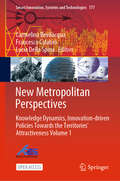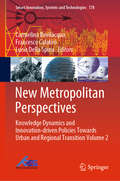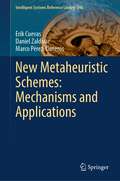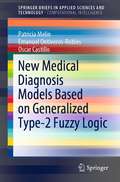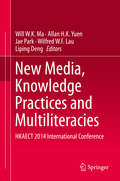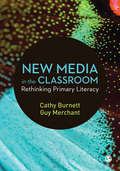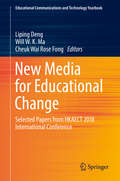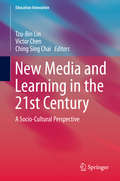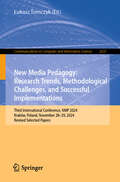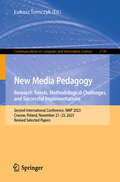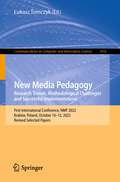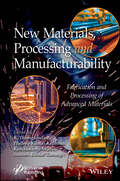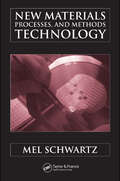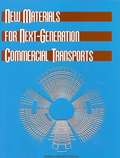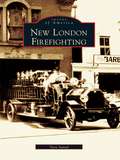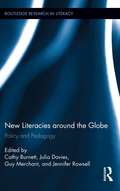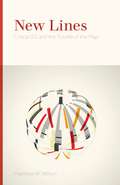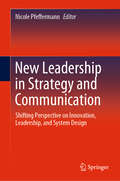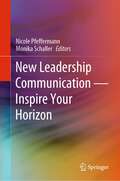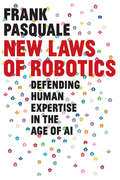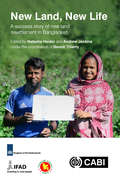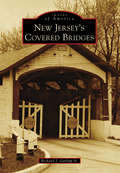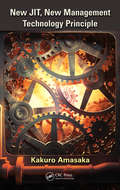- Table View
- List View
New Metropolitan Perspectives: Knowledge Dynamics, Innovation-driven Policies Towards the Territories’ Attractiveness Volume 1 (Smart Innovation, Systems and Technologies #177)
by Francesco Calabrò Lucia Della Spina Carmelina BevilacquaThis open access book presents the outcomes of the symposium “NEW METROPOLITAN PERSPECTIVES,” held at Mediterranea University, Reggio Calabria, Italy on May 26–28, 2020.Addressing the challenge of Knowledge Dynamics and Innovation-driven Policies Towards Urban and Regional Transition, the book presents a multi-disciplinary debate on the new frontiers of strategic and spatial planning, economic programs and decision support tools in connection with urban–rural area networks and metropolitan centers. The respective papers focus on six major tracks: Innovation dynamics, smart cities and ICT; Urban regeneration, community-led practices and PPP; Local development, inland and urban areas in territorial cohesion strategies; Mobility, accessibility and infrastructures; Heritage, landscape and identity;and Risk management,environment and energy. The book also includes a Special Section on Rhegion United Nations 2020-2030. Given its scope, the book will benefit all researchers, practitioners and policymakers interested in issues concerning metropolitan and marginal areas.
New Metropolitan Perspectives: Knowledge Dynamics and Innovation-driven Policies Towards Urban and Regional Transition Volume 2 (Smart Innovation, Systems and Technologies #178)
by Francesco Calabrò Lucia Della Spina Carmelina BevilacquaThis book presents the outcomes of the symposium “NEW METROPOLITAN PERSPECTIVES,” held at Mediterranea University, Reggio Calabria, Italy on May 26–28, 2020.Addressing the challenge of Knowledge Dynamics and Innovation-driven Policies Towards Urban and Regional Transition, the book presents a multi-disciplinary debate on the new frontiers of strategic and spatial planning, economic programs and decision support tools in connection with urban–rural area networks and metropolitan centers. The respective papers focus on six major tracks: Innovation dynamics, smart cities and ICT; Urban regeneration, community-led practices and PPP; Local development, inland and urban areas in territorial cohesion strategies; Mobility, accessibility and infrastructures; Heritage, landscape and identity;and Risk management,environment and energy. The book also includes a Special Section on Rhegion United Nations 2020-2030. Given its scope, the book will benefit all researchers, practitioners and policymakers interested in issues concerning metropolitan and marginal areas.
New Metaheuristic Schemes: Mechanisms and Applications (Intelligent Systems Reference Library #246)
by Erik Cuevas Daniel Zaldívar Marco Pérez-CisnerosRecently, novel metaheuristic techniques have emerged in response to the limitations of conventional approaches, leading to enhanced outcomes. These new methods introduce interesting mechanisms and innovative collaborative strategies that facilitate the efficient exploration and exploitation of extensive search spaces characterized by numerous dimensions. The objective of this book is to present advancements that discuss novel alternative metaheuristic developments that have demonstrated their effectiveness in tackling various complex problems. This book encompasses a variety of emerging metaheuristic methods and their practical applications. The content is presented from a teaching perspective, making it particularly suitable for undergraduate and postgraduate students in fields such as science, electrical engineering, and computational mathematics. The book aligns well with courses in artificial intelligence, electrical engineering, and evolutionary computation. Furthermore, the material offers valuable insights to researchers within the metaheuristic and engineering communities. Similarly, engineering practitioners unfamiliar with metaheuristic computation concepts will recognize the pragmatic value of the discussed techniques. These methods transcend mere theoretical tools that have been adapted to effectively address the significant real-world problems commonly encountered in engineering domains.
New Medical Diagnosis Models Based on Generalized Type-2 Fuzzy Logic (SpringerBriefs in Applied Sciences and Technology)
by Oscar Castillo Patricia Melin Emanuel Ontiveros-RoblesThis book presents different experimental results as evidence of the good results obtained compared with respect to conventional approaches and literature references based on fuzzy logic. Nowadays, the evolution of intelligence systems for decision making has been reached considerable levels of success, as these systems are getting more intelligent and can be of great help to experts in decision making. One of the more important realms in decision making is the area of medical diagnosis, and many kinds of intelligence systems provide the expert good assistance to perform diagnosis; some of these methods are, for example, artificial neural networks (can be very powerful to find tendencies), support vector machines, that avoid overfitting problems, and statistical approaches (e.g., Bayesian). However, the present research is focused on one of the most relevant kinds of intelligent systems, which are the fuzzy systems. The main objective of the present work is the generation of fuzzy diagnosis systems that offer competitive classifiers to be applied in diagnosis systems. To generate these systems, we have proposed a methodology for the automatic design of classifiers and is focused in the Generalized Type-2 Fuzzy Logic, because the uncertainty handling can provide us with the robustness necessary to be competitive with other kinds of methods. In addition, different alternatives to the uncertainty modeling, rules-selection, and optimization have been explored. Besides, different experimental results are presented as evidence of the good results obtained when compared with respect to conventional approaches and literature references based on Fuzzy Logic.
New Media, Knowledge Practices and Multiliteracies
by Jae Park Will W.K. Ma Allan H.K. Yuen Wilfred W.F. Lau Liping DengThis volume highlights key aspects of new media, knowledge practices and multiliteracies in communication and education, providing readers with a range of empirical findings, novel theories and applications. The reports also include best practices, case studies, innovative solutions and lessons learned with regard to three core fields: (1) New media: discussions on the effects of traditional and new media, legal risks concerning social media, the effects of media intervention on help-seeking attitudes, obstacles of using tablets for learning, qualitative interpretation of media reporting, use of social media for enhancing design practices, and news-reading habits; (2) Knowledge practices: exploration of online viewing and lifestyles, reform of school management models, undergraduate students' mathematics learning experiences, perceived accounting ethics and online knowledge sharing, creating knowledge repositories, digital technologies outside school, smartphone usage and life satisfaction, and cultural differences and isomerism; and (3) Multiliteracies: studies on learning style inventories, the impact of ICT in interdisciplinary approaches, ePortfolios for learning, video production and generic skills enhancement, mobile-assisted collaborative learning, and the effects of project-based learning on student achievements. The reports presented are from various countries and organizations.
New Media in the Classroom: Rethinking Primary Literacy
by Cathy Burnett Guy Merchant‘This an exciting publication that offers authentic approaches for educators to meet challenges of the literacy that students need in our evolving digital landscape.’ Maureen Walsh, Adjunct Professor, Australian Catholic University and Honorary Professor, The University of Sydney ‘In this significant new text, Cathy Burnett and Guy Merchant foreground the affective, embodied and emergent nature of making meaning with new media.’ Teresa Cremin, The Open University The rise of new media technologies has changed the ways in which children engage with texts and this has implications for literacy provision in schools. Drawing on research exploring new media practices within and outside school, this book explains and encourages classroom activity that makes purposeful and appropriate use of these literacies and is underpinned by a set of guiding principles for teaching literacy in contemporary times. Key topics include: Building on children’s experiences in and out of school Supporting children to draw on multiple modes and media to develop and convey meaning Developing a responsive approach to literacy provision Investigating ways of encouraging collaboration through and around digital media Encouraging children to use digital media safely and advantageously This is essential reading for primary English or elementary language arts modules on initial teacher education courses including university-based and schools-based routes into teaching and also for current teachers wishing to enhance their own literacy teaching. Cathy Burnett is Professor of Literacy and Education at Sheffield Hallam University. Guy Merchant is Professor of Literacy in Education at Sheffield Hallam University.
New Media in the Classroom: Rethinking Primary Literacy
by Cathy Burnett Guy Merchant‘This an exciting publication that offers authentic approaches for educators to meet challenges of the literacy that students need in our evolving digital landscape.’ Maureen Walsh, Adjunct Professor, Australian Catholic University and Honorary Professor, The University of Sydney ‘In this significant new text, Cathy Burnett and Guy Merchant foreground the affective, embodied and emergent nature of making meaning with new media.’ Teresa Cremin, The Open University The rise of new media technologies has changed the ways in which children engage with texts and this has implications for literacy provision in schools. Drawing on research exploring new media practices within and outside school, this book explains and encourages classroom activity that makes purposeful and appropriate use of these literacies and is underpinned by a set of guiding principles for teaching literacy in contemporary times. Key topics include: Building on children’s experiences in and out of school Supporting children to draw on multiple modes and media to develop and convey meaning Developing a responsive approach to literacy provision Investigating ways of encouraging collaboration through and around digital media Encouraging children to use digital media safely and advantageously This is essential reading for primary English or elementary language arts modules on initial teacher education courses including university-based and schools-based routes into teaching and also for current teachers wishing to enhance their own literacy teaching. Cathy Burnett is Professor of Literacy and Education at Sheffield Hallam University. Guy Merchant is Professor of Literacy in Education at Sheffield Hallam University.
New Media for Educational Change: Selected Papers from HKAECT 2018 International Conference (Educational Communications and Technology Yearbook)
by Liping Deng Will W. Ma Cheuk Wai FongThis book gathers selected papers presented at the Hong Kong Association for Educational Communications and Technology 2018 International Conference on the theme of “new media for educational change: effects on learning and reflection on practice”. It contributes to a scholarly discussion that goes beyond what new media can contribute to education, and reflects on best practices as well as lessons learned by applying new media in a wide range of fields. Scholars from educational technology, journalism, higher education, etc. share their findings in a number of formats, such as empirical research, case studies of best practices, literature reviews, etc. The topics addressed include but are not limited to media practice, application of innovative technologies, MOOCs in higher education, social media for learning, gamification, learning analytics, and comparative studies.
New Media and Learning in the 21st Century
by Ching Sing Chai Tzu-Bin Lin Victor ChenThis volume brings together conceptualizations and empirical studies that explore the socio-cultural dimension of new media and its implications on learning in the 21st century classroom. The authors articulate their vision of new-media-enhanced learning at a global level. The high-level concept is then re-examined for different degrees of contextualization and localization, for example how a specific form of new media (e-reader) changes specific activities in different cultures. In addition, studies based in Singapore classrooms provide insights as to how these concepts are being transformed and implemented by a co-constructive effort on the part of researchers, teachers and students. Singapore classrooms offer a unique environment to study the theory-practice nexus in that they are high achieving, implicitly grounded in the eastern cultural values and well-equipped with ICT infrastructure. While these studies are arguably the state-of-the-art exemplars that synergize socio-cultural and technological affordances of the current learning environments, they also serve as improvable ideas for further innovations. The interplay between theory and practice lends support to the reciprocal improvements for both. This book contributes to the continuing debate in the field, and will lead to better learning environments in the 21st century.
New Media Pedagogy: Third International Conference, NMP 2024, Kraków, Poland, November 28–29, 2024, Revised Selected Papers (Communications in Computer and Information Science #2537)
by Łukasz TomczykThis volume constitutes the revised selected papers of 3rd International Conference on New Media Pedagogy, NMP 2024, in Kraków, Poland, during November 28–29, 2024. The 23 full papers included in this book were carefully reviewed and selected from 72 submissions. They were organized in topical sections as follows: Innovative ICT applications in education; AI in education.
New Media Pedagogy: Second International Conference, NMP 2023, Cracow, Poland, November 21–23, 2023, Revised Selected Papers (Communications in Computer and Information Science #2130)
by Łukasz TomczykThis volume constitutes selected papers presented during the Second International Conference on New Media Pedagogy: Research Trends, Methodological Challenges, and Successful Implementations, NMP 2023, held in Cracow, Poland, in November 2023. The 29 papers presented were reviewed and selected from 90 submissions. They focus on recent research and emerging concerns in the field of media pedagogy, such as determinants of teachers' functioning in computerised schools, digitally assisted didactics, ICT-based solutions for teaching support, e-learning during crisis, digital inclusion and exclusion, Artificial intelligence in education and more.
New Media Pedagogy: First International Conference, NMP 2022, Kraków, Poland, October 10–12, 2022, Revised Selected Papers (Communications in Computer and Information Science #1916)
by Łukasz TomczykThis volume constitutes selected papers presented during the First International Conference on New Media Pedagogy: Research Trends, Methodological Challenges and Successful Implementations, NMP 2022, held in Kraków, Poland, in October 2022. The 20 papers presented were thoroughly reviewed and selected from the 55 qualified submissions. They present recent research in the areas of teacher education in the information society, digitally-enhanced didactics, pedagogical innovations using ICT, e-learning, blended learning, crisis e-learning, digital inclusion and exclusion, identity of media pedagogy, and more.
New Materials, Processing and Manufacturability: Fabrication and Processing of Advanced Materials
by Kamalakanta Muduli R. Thanigaivelan Pradeep Kumar Krishnan Santosh Kumar TamangThe book focuses on multiple areas of manufacturing, including cutting-edge material processing technologies, custom-made materials, metallic and non-metallic materials, new engineering experiments, contemporary machining, joining, surface modification, and process optimization techniques. Readers will find in this volume an extensive exploration of various advanced manufacturing and material engineering topics. It includes a detailed examination of aluminum grades and their applications, an overview of cold spray additive manufacturing, and a discussion on Gas Metal Arc Welding (GMAW) for cladding low-carbon steel plates. The volume also presents innovative approaches to brake pedal design using topology optimization, analysis of resistance-spot welding quality, and the impact of shot peening on the corrosion behavior of SiC Particle Reinforced Aluminum Composite. It highlights crucial factors in 3D printed component strength, reviews 3D milling operations with ABAQUS, and delves into the rare ferroelectric material Fresnoite. The book surveys visual sensing technologies for weld pool analysis, simulates Claus Sulfur Recovery Units with Aspen Plus, and discusses ultrasonic-assisted stir casting for metal matrix nanocomposites. It also covers the joining of dissimilar magnesium alloys, advancements in electrochemical surface coatings, unconventional machining techniques, surface coating processes using pulsed power systems, natural fiber-reinforced composite fabrication, and process parameter optimization in laser beam welding using NSGA-II. Audience The book will interest researchers in academia and industry engineers in advanced manufacturing, materials science, surface science, adhesion and coatings, production engineering, civil engineering, and welding.
New Materials, Processes, and Methods Technology
by Mel SchwartzMaterials selection is a crucial factor in determining the cost, quality, and corrosion protection for every engineering project. The variety of increasingly durable materials and their combinations, coupled with the rise of new and more critical service requirements and the demand for lower costs, have expanded upon trial-and-error criteria into m
New Materials for Next-Generation Commercial Transports
by Committee on New Materials for Advanced Civil AircraftThe major objective of this book was to identify issues related to the introduction of new materials and the effects that advanced materials will have on the durability and technical risk of future civil aircraft throughout their service life. The committee investigated the new materials and structural concepts that are likely to be incorporated into next generation commercial aircraft and the factors influencing application decisions. Based on these predictions, the committee attempted to identify the design, characterization, monitoring, and maintenance issues that are critical for the introduction of advanced materials and structural concepts into future aircraft.
New London Firefighting (Images of America)
by Tara SamulThe New London Fire Department was born in 1767 when Nathaniel Shaw Jr. presented the city with its first fire engine. Since then, New London has had a successful history of emergency medical service, heroic assistance during natural disasters, and fantastic 0firefighting. The city's most notorious fire occurred on September 6, 1781. Under the command of the infamous traitor and New London County native, Gen. Benedict Arnold, British troops set New London ablaze. A great deal of life and property was lost. At a 1786 town meeting, residents began the first regular fire company, which eventually evolved into eight volunteer companies. New London Firefighting proudly chronicles its initial humble volunteer system up to today's technologically advanced apparatus and career personnel.
New Literacies around the Globe: Policy and Pedagogy (Routledge Research in Literacy)
by Jennifer Rowsell Cathy Burnett Guy Merchant Julia DaviesThe increasing popularity of digitally-mediated communication is prompting us to radically rethink literacy and its role in education; at the same time, national policies have promulgated a view of literacy focused on the skills and classroom routines associated with print, bolstered by regimes of accountability and assessments. As a result, teachers are caught between two competing discourses: one upholding a traditional conception of literacy re-iterated by politicians and policy-makers, and the other encouraging a more radical take on 21st century literacies driven by leading edge thinkers and researchers. There is a pressing need for a book which engages researchers in international dialogue around new literacies, their implications for policy and practice, and how they might articulate across national boundaries. Drawing on cutting edge research from the USA, Canada, UK, Australia and South Africa, this book is a pedagogical and policy-driven call for change. It explores studies of literacy practices in varied contexts through a refreshingly dialogic style, interspersed with commentaries which comment on the significance of the work described for education. The book concludes on the ‘conversation’ developed to identify key recommendations for policy-makers through a Charter for Literacy Education. .
New Lines: Critical GIS and the Trouble of the Map
by Matthew W. WilsonNew Lines takes the pulse of a society increasingly drawn to the power of the digital map, examining the conceptual and technical developments of the field of geographic information science as this work is refracted through a pervasive digital culture. Matthew W. Wilson draws together archival research on the birth of the digital map with a reconsideration of the critical turn in mapping and cartographic thought. Seeking to bridge a foundational divide within the discipline of geography—between cultural and human geographers and practitioners of Geographic Information Systems (GIS)—Wilson suggests that GIS practitioners may operate within a critical vacuum and may not fully contend with their placement within broader networks, the politics of mapping, the rise of the digital humanities, the activist possibilities of appropriating GIS technologies, and more.Employing the concept of the drawn and traced line, Wilson treads the theoretical terrain of Deleuze, Guattari, and Gunnar Olsson while grounding their thoughts with the hybrid impulse of the more-than-human thought of Donna Haraway. What results is a series of interventions—fractures in the lines directing everyday life—that provide the reader with an opportunity to consider the renewed urgency of forceful geographic representation. These five fractures are criticality, digitality, movement, attention, and quantification. New Lines examines their traces to find their potential and their necessity in the face of our frenetic digital life.
New Leadership in Strategy and Communication: Shifting Perspective on Innovation, Leadership, and System Design
by Nicole PfeffermannThis contributed volume provides new approaches, fresh ideas, valuable insights, and latest research in leadership—from strategic business (model) innovation to system design and humanity—and is a knowledge source and inspirational guide for scientists and practitioners alike.A key theme is the provision of an integrated perspective on leadership in strategy and communication which allow (senior) leaders, managing di-rectors, project managers, and individuals to (1) better link strategic busi-ness innovation and leadership and (2) shift to the new human self-lead-ership paradigm and in particularly leadership advances that consider ideas from multiple disciplines and transgenerational views. That includes a new understanding about knowledge, learning and change and how leaders re-discover and develop their human abilities, which include intui-tion/strength, balance and clarity, projection-reflection, and wisdom.This volume also makes an important contribution to the evolving aca-demic domain by providing the latest insights on trauma research, DNA healing, system (re)design, and growth & abundance mindset in the ad-vanced co-creation age.
New Leadership Communication—Inspire Your Horizon
by Nicole Pfeffermann Monika SchallerThis new book aims at inspiring managers and passionate, influential (new) leaders to re-think how to address communication markets, challenge the way how to orchestrate communication instruments, find new ways to communicate the New, and cultivate a positive communication culture. Leadership communication is a critical success factor of senior management teams and (new) leaders (game changer, pioneers) in the digital and human age to better interact and connect with others; drive innovation and adoption processes; and empower young minds with joy, abundance, and wisdom. In the classical view, leadership communication is part of management communication which means leaders primarily use instruments focusing on teams, presentations, and negotiations. In the modern view, however, new leadership communication also encompasses social media and innovation communication. It dives deeper into ground rules for effective leadership communication and key themes, such as virtual communication, innovation and leadership, and communication model innovation. Be the inspiration! Become a new leader and shape the world.
New Laws of Robotics: Defending Human Expertise In The Age Of Ai
by Frank PasqualeAI is poised to disrupt our work and our lives. We can harness these technologies rather than fall captive to them—but only through wise regulation.Too many CEOs tell a simple story about the future of work: if a machine can do what you do, your job will be automated. They envision everyone from doctors to soldiers rendered superfluous by ever-more-powerful AI. They offer stark alternatives: make robots or be replaced by them.Another story is possible. In virtually every walk of life, robotic systems can make labor more valuable, not less. Frank Pasquale tells the story of nurses, teachers, designers, and others who partner with technologists, rather than meekly serving as data sources for their computerized replacements. This cooperation reveals the kind of technological advance that could bring us all better health care, education, and more, while maintaining meaningful work. These partnerships also show how law and regulation can promote prosperity for all, rather than a zero-sum race of humans against machines.How far should AI be entrusted to assume tasks once performed by humans? What is gained and lost when it does? What is the optimal mix of robotic and human interaction? New Laws of Robotics makes the case that policymakers must not allow corporations or engineers to answer these questions alone. The kind of automation we get—and who it benefits—will depend on myriad small decisions about how to develop AI. Pasquale proposes ways to democratize that decision making, rather than centralize it in unaccountable firms. Sober yet optimistic, New Laws of Robotics offers an inspiring vision of technological progress, in which human capacities and expertise are the irreplaceable center of an inclusive economy.
New Land, New Life: A success story of new land resettlement in Bangladesh
by Md. Rezaul Karim Mihir Kumar Chakraborty Bazlul Karim Kiran Sankar Sarker Md. Robiul Islam Nujulee Begum Edward Mallorie Koen De WildeThe Ganges-Brahmaputra-Meghna delta has newly emerged 'char' islands, resulting from the deposition of sediment, which are very vulnerable, socially, institutionally and environmentally. This book explains how the governments of Bangladesh and the Netherlands and the International Fund for Agricultural Development cooperated on a land-based rural development project to give settlers security and purpose. It details how they engaged communities and civil societies, and implemented an infrastructure aimed at reducing flooding, improving drainage, and providing adequate drinking water and sanitation. The book describes the project's application to crop and animal agriculture, and the development of value chains and encouragement of female participation. It considers the financial underpinning and infrastructure, as well as how to ensure the impacts of the scheme are enduring. The scheme serves as a model for support projects to vulnerable groups faced with climate change and other environmental challenges. This book is suitable for students, researchers, specialists and practitioners in rural development, water resources, land management and soil science.
New Jersey's Covered Bridges
by Richard J. Garlipp Jr.In the 18th and 19th centuries, covered bridges dotted the landscape of New Jersey, providing safe passage to travelers. Forty-five covered bridges once crossed waterways in all corners of the state. Perhaps the most extraordinary examples of these wooden bridges were found along the western border, crossing the Delaware River into neighboring Pennsylvania. These bridges were feats of construction and engineering but were ultimately unable to prevent the inevitable fate of almost all the covered bridges of the state, namely ice, floods, and fire as well as the development of new materials and technology. Today, only one covered bridge survives in New Jersey. The Green Sergeant's covered bridge in Hunterdon County was constructed over the Wickecheoke Creek in 1872 and has stood the test of time. New Jersey's Covered Bridges showcases the rich transportation history of these structures and pictorially honors the lost ones.
New JIT, New Management Technology Principle
by Kakuro AmasakaNew JIT, New Management Technology Principle contains the previously published, updated, and new works of renowned scientist, scholar, and consultant Kakuro Amasaka. This book details the Just-in-Time (JIT) quality management strategy, exploring the cutting edge of a new management technology principle that surpasses what traditional JIT has accomp
New Itinerant Electron Models of Magnetic Materials
by Gui-De TangThis book highlights a series of new itinerant electron models proposed based on the experimental results of electron spectra obtained since 1970. Although conventional magnetic ordering models were established before 1960, many problems remain to be solved. The new models in this book include an O 2p itinerant electron model for magnetic oxides, a new itinerant electron model for magnetic metals, and a Weiss electron pair model for the origin of magnetic ordering energy of magnetic metals and oxides. With these models, the book explains typical magnetic ordering phenomena including those that cannot be explained using conventional models. These new models are easier to understand than the conventional magnetic ordering models.
